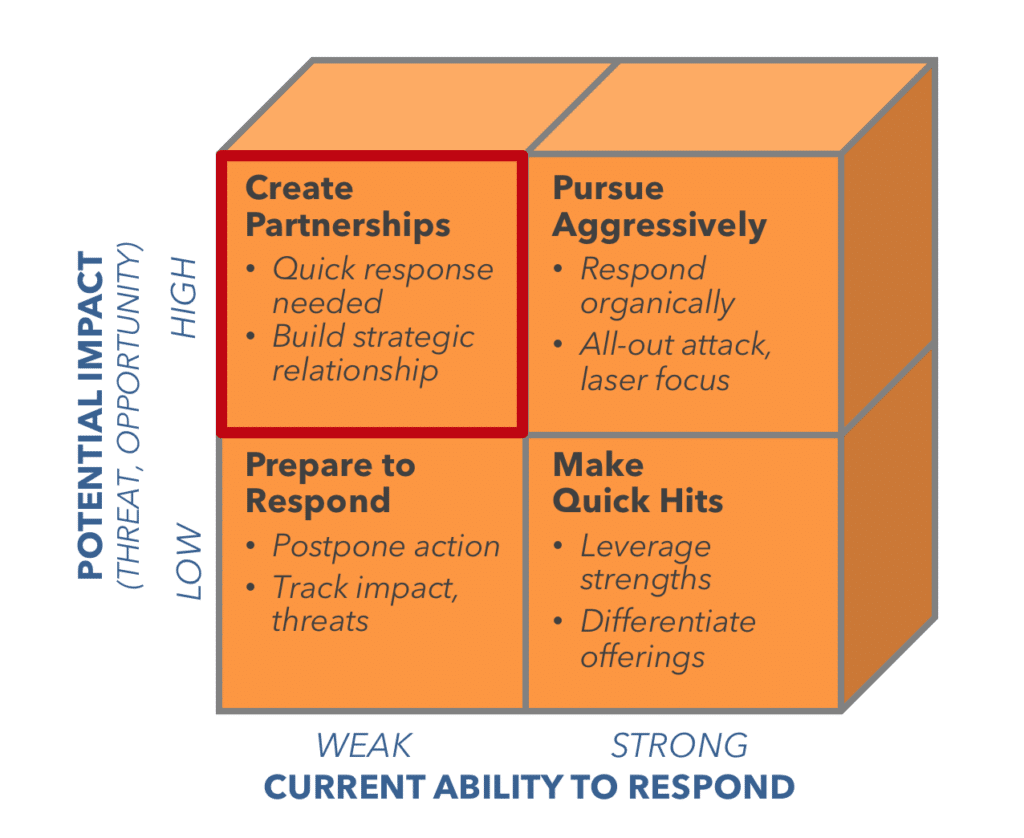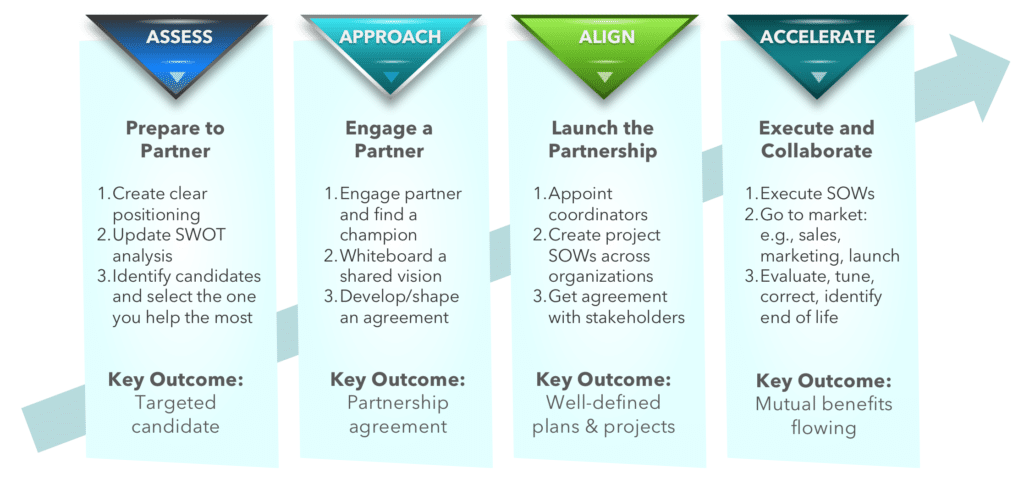Partnering: Driving Critical Growth in a Post-Pandemic World

Restarting the economy following the economic damage inflicted by the COVID-19 crisis is a huge challenge. Small and medium enterprises (SMEs) in particular face existential risk if they can’t regain previous levels of revenue and profit in a short period of time.
Large enterprises harness strategic partnerships as a powerful growth driver. For example, in a 2018 healthcare partnership, giants Amazon, Berkshire Hathaway, and JPMorgan Chase began pooling resources to remove waste and improve patient experience. If giant corporations choose to accelerate business by creating a strategic partnership that combines resources, surely partnering is even more critical for small and medium enterprises.
A 2020 PwC survey and analysis conducted before the pandemic revealed these surprising results, as reported on Forbes.com:
“Forty-nine percent of executives said they were planning a new strategic alliance or JV [joint venture] in the next year to help drive corporate growth and/or profitability. That percentage was more than planned new M&A activity (42 percent), outsourcing (21 percent), or a business sale or market exit (16 percent). That was then—the pandemic could overwhelm all of those issues.”
The importance of partnering continues after the advent of COVID-19 as well: In a recent article on surviving and thriving post-COVID-19, corporate strategy advisor McKinsey & Company identified “fostering value creation through partnering” as one of the top three factors that will most impact growth and scalability in coming out of the current crisis.
Since beginning to build successful strategic partnerships in 1990, I’ve continued to employ partnering as a critical business tool for every company I’ve helped since. Example outcomes from applying partnering include $65 million in incremental first-year revenue generation, new product launches with first-year revenue in the millions of dollars, and a $200 million acquisition.
My key takeaway from these experiences is this: A company that knows how to partner has a distinct advantage over its competitors. When it lacks internally what it needs to pursue a high-impact opportunity, it can continue to grow rapidly if its leadership knows when and how to partner.
Obstacles to Partnering
If strategic partnerships can accelerate growth, why are many CEOs reluctant to pursue them? Maybe they have perceptions about partnering that are inaccurate:
| Fiction | Fact |
| “Partnerships favor the larger (or smaller) party.” | Successful partnerships always deliver critical benefits to both parties. |
| “I have a better chance of winning the lottery than being successful in a partnership.” | While partnership failure estimates range from 55–80%, using a proven process for evaluating when and how to partner ensures success. |
| “Partnerships are too complex to manage effectively.” | Well-executed partnerships ensure that proven management processes are established to engage key stakeholders. |
| “The ROI doesn’t justify the effort.” | Successful partnerships can rapidly deliver new business opportunities with higher margins. |
| “Partnering is too complicated for the people we have.” | Bright businesspeople armed with a clear and proven methodology quickly learn how to build growth-accelerating alliances. |
What Is a “Self-Fueling” Partnership?
To succeed in partnering, CEOs need proven processes to guide them. I developed the Self-Fueling Partnerships (SFP) methodology based on decades of building successful business relationships that generated significant incremental revenue. It’s easily comprehended and executed, and it can equip a new generation of business leaders with an intuitive feel for acquiring growth-generating resources that will enable them to accelerate beyond organic growth.
When I first began building partnerships for a billion-dollar tech company, we avoided what we saw as meaningless “strategic alliances” that started and ended with a press release. We laughingly called them Barney announcements: “I love you, you love me . . .” We were at least partially right: If a strategic partnership doesn’t achieve tangible growth, it’s a waste of time.
CEOs who approve “press announcement partnerships” often attribute their disappointing lack of results to partnering in general, rather than to poor execution. It’s better to take a more intentional approach: only consider partnering when you’re (1) faced with a high-impact threat or opportunity and (2) lack the ability to respond strongly.

Only consider partnering when you’re faced with a high-impact threat or opportunity and you lack the ability to respond strongly
When you need to fill resource gaps faster (e.g., new technologies and products, broader distribution, increased staffing), leverage the existing assets of other companies. The key to creating a successful partnership is to identify the target company’s need for the value that you can deliver them. Deliberately seek out companies with complementary needs to form a “self-fueling partnership.”
Definition: Self-Fueling Partnership
A Self-Fueling Partnership is a relationship intentionally structured so that a positive result for the first party drives it to take actions that produce positive results for the second party, and vice versa.
When Partner A takes actions to benefit Partner B, and that causes Partner B to take actions that benefit Partner A, the relationship becomes “self-fueling.” It grows with far less pushing from behind than more common partnerships. Of course, effective execution to reach mutually desired outcomes is still required, but the level of management effort is substantially reduced. To create a self-fueling partnership requires a deliberate approach to partnering.
The Self-Fueling Partnership Methodology
If you’re new to partnering, where should you start? The Self-Fueling Partnerships methodology comprises four major phases—Assess, Approach, Align, and Accelerate—each with several clear steps.

The first phase, Assessment, comprises four steps, with each one critical to success:
- Positioning. It’s impossible to evaluate your worth to a partner without a clear, crisp understanding of how your own company fits into the business ecosystem. Identify who you serve within what types of organizations, which market category best describes your offerings, why people buy what your offerings, who competes with you and their weaknesses, and what your key differentiators are.
- SWOT Analysis. Ascertain your company’s Strengths (internal positives), Weaknesses (internal negatives), Opportunities (external positives), and Threats (external negatives). Look at its ability to respond with its current resources to the threat or opportunity most critical to protecting and growing your business. If the ability to respond is weak and you need to act quickly, finding a partner with the needed resources can accelerate your response time.
- Identify Candidates. In exchange for filling resource gaps, you must offer a partner significant value. While that may sound simple, it takes market knowledge and careful research to discern which companies could benefit the most from your help. Brainstorm a long list of enterprises (suggested target is 20) that offer access to customers, new technology, or other resources critical to accelerating your company’s growth.
Target the Best. Select the partner you help the most, rather than prioritizing based only on your own needs. Creating a highly successful partnership depends on allying yourself with a company that values the benefits received from your company so much that their initial and ongoing enthusiasm will result in a significant positive impact on accelerating the growth of your enterprise.
The other three stages build upon the Assess phase. After choosing the right partner, take deliberate steps to approach them and find an internal champion, develop a shared vision, and design and execute a partnership agreement (the Approach phase). Careful planning in the form of well-defined projects with assigned responsibilities ensures readiness to launch the partnership (the Align phase). Then it’s time for the launch, which involves close collaboration between the partners as each executes their part of the plan (the Accelerate phase). Finally, ongoing care and feeding through regular communication and evaluation ensures that benefits from the relationship continue to flow to each party.
Partnering Resources
If you and your company are new to partnering, or if you’d like a fresh perspective, check out a new resource I’ve founded called Partnering Source (partneringsource.com). Accepting a free membership brings you a regular newsletter with tips, tricks, and ideas and information from the latest articles. You’ll also become a member of its Partnering Forum, where you can ask questions and get answers from partnering experts.
Visit Partnering Source at partneringsource.com.
[1] Kate Vitasek, “The Increasing Need for Strategic Alliances,” Forbes.com, March 28, 2020.
[2] Kevin Sneader and Bob Sternfels, “From Surviving to Thriving: Reimagining the Post-COVID-19 Return,” McKinsey.com, May 1, 2020.






